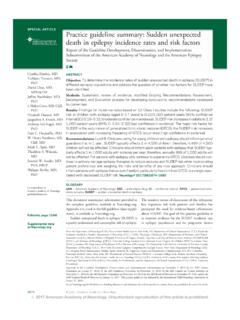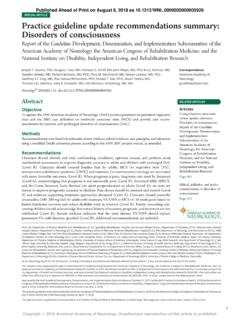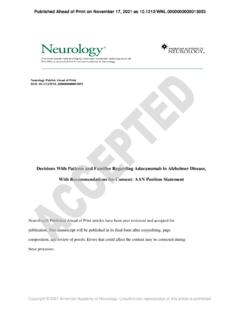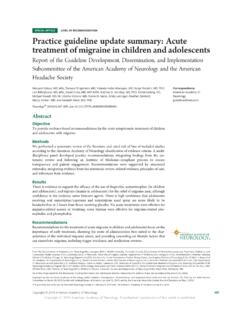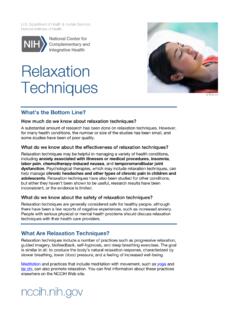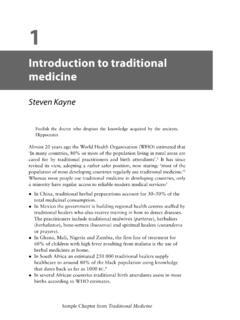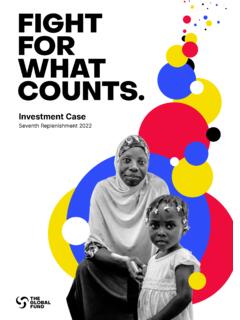Transcription of Summaryofevidence-basedguideline:Complementary and ...
1 SPECIAL ARTICLE. Summary of evidence-based guideline: complementary and alternative medicine in multiple sclerosis Report of the Guideline Development Subcommittee of the American Academy of Neurology Vijayshree Yadav, MD, ABSTRACT. MCR Objective: To develop evidence-based recommendations for complementary and alternative Christopher Bever, Jr., medicine (CAM) in multiple sclerosis (MS). MD, MBA, FAAN. Methods: We searched the literature (1970 March 2011; March 20112 September 2013. James Bowen, MD. MEDLINE search), classified articles, and linked recommendations to evidence. Allen Bowling, MD, PhD. Bianca Weinstock- Results and recommendations: Clinicians might offer oral cannabis extract for spasticity symp- Guttman, MD toms and pain (excluding central neuropathic pain) (Level A). Clinicians might offer tetrahydro- Michelle Cameron, MD, cannabinol for spasticity symptoms and pain (excluding central neuropathic pain) (Level B).
2 PT Clinicians should counsel patients that these agents are probably ineffective for objective Dennis Bourdette, MD, spasticity (short-term)/tremor (Level B) and possibly effective for spasticity and pain (long- FAAN term) (Level C). Clinicians might offer Sativex oromucosal cannabinoid spray (nabiximols). Gary S. Gronseth, MD, for spasticity symptoms, pain, and urinary frequency (Level B). Clinicians should counsel pa- FAAN tients that these agents are probably ineffective for objective spasticity/urinary incontinence Pushpa Narayanaswami, (Level B). Clinicians might choose not to offer these agents for tremor (Level C). Clinicians MBBS, DM, FAAN might counsel patients that magnetic therapy is probably effective for fatigue and probably ineffective for depression (Level B); fish oil is probably ineffective for relapses, disability, fatigue, MRI lesions, and quality of life (QOL) (Level B); ginkgo biloba is ineffective for cogni- Correspondence to tion (Level A) and possibly effective for fatigue (Level C); reflexology is possibly effective for American Academy of Neurology: paresthesia (Level C); Cari Loder regimen is possibly ineffective for disability, symptoms, depression, and fatigue (Level C); and bee sting therapy is possibly ineffective for relapses, disability, fatigue, lesion burden/volume, and health-related QOL (Level C).
3 Cannabinoids may cause adverse effects. Clinicians should exercise caution regarding standardized vs non- standardized cannabis extracts and overall CAM quality control/nonregulation. Safety/effi- cacy of other CAM/CAM interaction with MS disease-modifying therapies is unknown. Neurology 2014;82:1083 1092. GLOSSARY. AAN 5 American Academy of Neurology; AE 5 adverse effect; CAM 5 complementary and alternative medicine ; CBD 5. cannabidiol; CI 5 confidence interval; DSM-IV 5 Diagnostic and Statistical Manual of Mental Disorders, 4th edition; EDSS 5. Expanded Disability Status Scale; FDA 5 US Food and Drug Administration; FSS 5 Fatigue Severity Scale; GB 5 ginkgo biloba; GNDS 5 Guy's Neurological Disability Scale; HRQOL 5 health-related QOL; MFIS 5 Modified Fatigue Impact Scale;. MS 5 multiple sclerosis; MSIS 5 Multiple Sclerosis Impact Scale; OCE 5 oral cannabis extract; PPMS 5 primary progressive MS; QOL 5 quality of life; RCT 5 randomized controlled trial; RRMS 5 relapsing-remitting MS; SAE 5 serious adverse effect.
4 SPMS 5 secondary progressive MS; THC 5 tetrahydrocannabinol; VAS 5 visual analog scale. complementary and alternative medicine (CAM) patients with MS,1-10 particularly among those who therapies are nonconventional therapies used in are female, have higher education levels, and report addition to or instead of physician-recommended poorer ,11 This document summarizes therapies . CAM use is prevalent in 33% 80% of extensive information provided in the complete Supplemental data at From the Department of Neurology ( , , ), Oregon Health & Science University and Department of Neurology ( , , ), Veterans Affairs Medical Center, Portland; MS Center of Excellence East ( ), VA Maryland Health Care System and Department of Neurology ( ), University of Maryland School of medicine , Baltimore; Multiple Sclerosis Center ( ), Swedish Neuroscience Institute, Seattle, WA.
5 Multiple Sclerosis Service and complementary and Alternative medicine Service ( ), Colorado Neurological Institute, Englewood; The Jacobs Neurological Institute ( ), Buffalo, NY; Department of Neurology ( ), University of Kansas Medical Center, Kansas City, KS; and Department of Neurology ( ), Beth Israel Deaconess Medical Center/Harvard Medical School, Boston, MA. Approved by the Guideline Development Subcommittee on January 12, 2013; by the Practice Committee on March 13, 2013; and by the AANI. Board of Directors on December 11, 2013. Go to for full disclosures. Funding information and disclosures deemed relevant by the authors, if any, are provided at the end of the article. 2014 American Academy of Neurology 1083. guideline, available as a data supplement on the conclusions and recommendations. We selected Neurology Web site at Tables e-1 the final level of obligation for compliance with a rec- through e-3 and appendices e-1 through e-6, cited ommendation (might/may, should, or must) after taking in the full guideline (data supplement), as well as into consideration the quality of evidence (Level A, B, references e1 e84, cited in this summary, are or C) and other factors ( , limited generalizability of available at the studies, safety/side effect concerns, availability of This guideline addresses the following questions: alternative treatments).
6 In patients with MS, Cannabinoids. Cannabinoids are a group of compounds 1. do CAM therapies reduce specific symptoms and with psychoactive properties. Tetrahydrocannabinol prevent relapses or disability? (THC) and cannabidiol (CBD) are the major cannabi- 2. can CAM use worsen MS or cause serious adverse noids of cannabis. Synthetic cannabinoids are chemically effects (SAEs)? related to THC. Orally administered cannabinoids 3. can CAM use interfere with MS disease-modifying (cannabis extract, synthetic THC), mucosally delivered therapies ? cannabinoids (cannabis extract oral spray, nabiximols [trade name Sativex]), and smoked cannabis have all DESCRIPTION OF THE ANALYTIC PROCESS This been studied for therapeutic effects in MS. guideline was developed in accordance with the 2004. American Academy of Neurology (AAN) process Oral cannabinoids (cannabis extract and THC).
7 The search After review of conflict of interest state- identified 9 studies (3 Class I,13-15 2 Class II,16,17 and 4. ments, the AAN selected a panel of experts. A medical Class III18-21). research librarian helped perform a comprehensive A large Class I study13 (N 5 630; patients with literature search, and the authors selected articles. relapsing-remitting MS [RRMS], primary progressive At least 2 authors independently rated each article MS [PPMS], and secondary progressive MS [SPMS];. (AAN therapeutic classification scheme). We linked 15 weeks) found that neither oral cannabis extract recommendation strength to the evidence quality. (OCE, THC with CBD) nor synthetic THC (Marinol). With regard to cannabis for pain, we reviewed studies had greater effect than placebo on the primary outcome evaluating pain associated with spasticity separately measure of spasticity as measured by total Ashworth from those evaluating pain specified to be of central scale22 change from baseline (mean change 6 SD: neuropathic origin and made separate recommenda- OCE: [ ], THC: [ ], placebo: tions.)
8 We performed Bonferroni correction for mul- [ ], p 5 ). However, in this same study,13 sig- tiple comparisons when necessary. nificantly more patients reported reduced spasticity symptoms in the treatment groups (secondary out- ANALYSIS OF EVIDENCE Because studies were comes spasticity/pain: OCE [52/46%], THC [51/. unavailable or, where available, had a high risk of bias, 50%], placebo [37/30%]). Sleep and muscle spasms were in conflict, or lacked statistical precision, we also improved in the treatment groups. found the evidence insufficient to support or refute In a second Class I study14 (N 5 249; stable MS, . the effectiveness of the following therapies in MS type unspecified; 12 weeks) the proportion of patients (table 1): acetyl-L-carnitine, acupuncture, biofeed- achieving relief of muscle stiffness was in the back, carnitine, chelation therapy, Chinese medicine , OCE group compared with in the placebo group chiropractic medicine , creatine monohydrate, dental (odds ratio , 95% confidence interval [CI] CI.
9 Amalgam replacement, glucosamine sulfate, hippother- ). Secondary outcomes (muscle stiffness and spasms, apy, hyperbaric oxygen, inosine, linoleic acid, low-dose pain, sleep) also improved in the cannabis group. naltrexone, massage therapy, mindfulness training, A third Class I study15 (N 5 57; RRMS, SPMS, music therapy, naturopathic medicine , neural therapy, PPMS), insufficiently powered, found no significant Padma 28, progressive muscle relaxation therapy, tai difference in objective spasticity (Ashworth scale) or chi, threonine, transdermal histamine, and yoga. Data patient-reported spasm frequency. also were insufficient to determine whether any CAM In both adequately powered Class I studies,13,14. therapies worsen MS or interfere with disease-modifying significantly more patients treated with cannabinoids therapies .
10 Reported reduced pain, whereas disability measures Evidence was available to develop practice recom- and health questionnaire results were not significantly mendations for use of bee venom therapy, cannabinoids, different between groups. One Class I study13 assessed ginkgo biloba (GB), lofepramine plus phenylalanine tremor and bladder symptoms and noted no signifi- with B12 (Cari Loder regimen), low-fat diet with cant difference in outcomes between patients treated omega-3 supplementation, magnetic therapy, and with cannabinoids and placebo. reflexology (table 2). This evidence is discussed herein Conclusions. OCE is established as effective for reduc- and includes only the studies that inform the ing patient-reported spasticity symptoms and pain 1084 Neurology 82 March 25, 2014. Table 1 CAM therapies with insufficient evidence to support specific practice recommendations for their use in multiple sclerosis CAM intervention Description Evidence MS types studied Adverse effects Mind2body medicine Biofeedback Active physiologic monitoring of a body 1 Class IIIe38 MSU.
